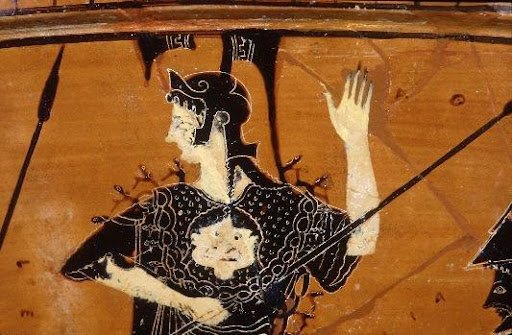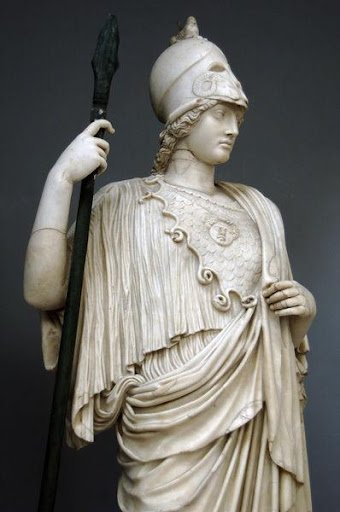Medusa Tattoos and the Modern Aegis
TW: This article contains repeated discussions of sexual assault and violence.
Since their conception, tattoos have been intended as a symbol on behalf of the wearer, through which life events, experiences, beliefs, and personality can be revealed to the world. A solid teardrop on the left side of the face symbolises a murder, a swallow symbolises time spent as a sailor, and within a new tradition, the face of Medusa symbolises surviving sexual assault or abuse. Now, just to clarify, I am by no means saying that taking comfort in the image of Medusa as a survivor of sexual assault, is historically incorrect. On the contrary, I’d like to explore why this image of Medusa being worn by a woman is actually, more accurate to Greek mythology than you’d think. If people take more comfort in the Roman interpretation, then of course take as much comfort as life offers. However, modern film and media very rarely tell the full story, and if you find yourself considering a Medusa tattoo or already wearing one, I’m sorry and I would encourage you to read on.
Having emerged through TikTok, the hashtag #medusatattoo has amassed over seventy million views. Alongside this hashtag is a frequently used audio which tells the story of Medusa, albeit from the 2010 Clash of the Titans film (which I despise but go off). The audio states;
“Just another beast to kill - Beast? Medusa was beautiful once, so beautiful as to tempt Poseidon. When he came for her she ran to Athena’s temple thinking that the goddess would protect her. she didn't. Poseidon took her on the cold floor. She prayed to Athena for comfort but the goddess felt nothing but disgust. She made sure no one would ever want medusa again. One look at the creature she has become would turn any living thing to stone”
First of all lets try not to look too deeply into their use of the word “tempt” as a cause of rape. The Medusa referenced in this audio clip is the same version being referenced through the tattoos, a Medusa who was a victim of rape by Poseidon, and who was cursed into monstrosity by Athena. However, this incarnation is not the Medusa of Greek mythology, as is often claimed. In actual fact this is a retelling by Roman writer Ovid. Ovid, writing in 8 AD, tells the Medusa story as;
“She was once most beautiful, and the jealous aspiration of many suitors. Of all her beauties none was more admired than her hair: I came across a man who recalled having seen her. They say that Neptune, lord of the seas, violated her in the temple of Minerva. Jupiter’s daughter turned away, and hid her chaste eyes behind her aegis. So that it might not go unpunished, she changed the Gorgon’s hair to foul snakes. And now, to terrify her enemies, numbing them with fear, the goddess wears the snakes, that she created, as a breastplate” - Ovid, Metamorphosis, Book 4 lines 850-858
By making Medusa’s monstrosity Athena’s fault Ovid bound the women together, when in the older Greek versions Athena’s real connection to Medusa was her ownership of the Aegis. The Aegis was a breastplate worn by Athena, into which was carved the face of Medusa. It was said to have the power to strike fear into anyone who dared face Athena in battle, in a way imbuing Athena with the petrifying powers of Medusa. Athena also had a symbolic connection to snakes, her only child Erechtheion was born as a serpent. Many ancient Greek depictions of Athena show her with a serpent at her side, along with her owl, as well as the Gorgon’s face on her breastplate. Ovid presumably built his retelling, where Medusa was a priestess of Athena, around this visual connection, through serpents.
520-515 BCE calyx painting. Athena wearing her aegis, with its snake-fringe and gorgon head, the Toledo Museum of Art.
However, considerably older Greek sources tell a very different story of Medusa. Hesiod writes that she had two sisters, also Gorgons, but only she had the power to turn people to stone (on the flip side of this she was also mortal, I guess you can’t have it all) . Hesiod also clarifies her connection to Poseidon, that they did lie together in order to have their two children, Chrysador and Pegasus, (which they mercifully left out of Disney’s Hercules since the children were born out of Medusa’s neck post-decapitation). Hesiod, writing in 800 BCE (that's nearly a thousand years before Ovid) does state that Medusa lay with the “Dark haired one in a soft meadow amid spring flowers'' (Theogony lines 270-280) which sounds perfectly fine, although the mention of flowers and meadows does suggest the loss of her virginity, but is certainly not conclusive assault. However, what Hesiod does prove is that Medusa’s monstrous nature was her own - women are not only capable of becoming “monsters'' at the whims of men, we have that ability in our own right. It also certainly confirms that Athena did not punish Medusa by making her a Gorgon. It has actually been theorised by poet Nikita Gill that perhaps Athena was blessing Medusa by making her a monster. This is a modern feminist take and whilst it’s a nice theory, theres no historic basis for it.
So why do I have an issue with the Ovid story being the basis for the Medusa tattoos? For two reasons, the needless victimisation of Medusa (many of Ovid’s female characters experience sexual assault) and secondly the villainisation of Athena.
Ovid creates an Athena who not only turns her back on her priestess being assaulted in her temple, but punishes her for it, and whilst Athena’s volatile nature is seen in many of her myths, the Ovid story of Medusa takes inspiration from another story, where a priestess of Athena’s is assaulted in her temple. However, this story has a very different ending.
The Athena Giustiniani: Roman copy of a Greek original. The visage of Medusa is visible on her draped chainmail-like Aegis.
This story is that of Kassandra of Troy, who was cursed to see the truthful future but was never believed when she spoke of it (a young woman never being believed…how sadly relevant to this article). During the sack of Troy she fled to the temple of Athena, a place of safety where violence was sacrilege, and she was pursued by a Greek warrior known as Ajax the Lesser (a title he really does deserve). When Kassandra clung to the statue of Athena for the goddess’ protection, Ajax ignored this sacred protection and raped Kassandra anyway, pulling her away by her hair, so violently the statue broke in Kassandra’s arms. Athena’s response to this was not to blame Kassandra, not to curse her or punish her. Instead, Athena rallied the gods behind her to punish not only Ajax, but the entire Greek army, for harming Kassandra. She demanded her fathers lightning bolts and even commanded Poseidon to send storms after the ships so that none of the Greeks would make it home. Ajax is drowned at sea but Athena is not satisfied, she curses his people for centuries, and they pay the price for his assault by sending their own daughters to Troy to serve in Athena’s temple as penance. Athena witnessed Kassandra’s assault, and instead of punishing Kassandra by transforming her into a monster, she hunts her rapist down, drowns him, destroys his allies and curses his homeland.
This is why the allocation of Athena as “the one who punished Medusa for her own rape” doesn’t match with the Athena of the ancient Greeks, only the Athena of Ovid, who was writing as a Roman at a much later time, taking his own creative liberties.
So what does Athena being Kassandra’s avenger have to do with the Medusa tattoos? Because Athena did all this for Kassandra, whilst wearing the Aegis. She wore the face of Medusa as she punished a rapist and all who protected him. To wear an Aegis, the face of Medusa, as a survivor of assault, is not simply taking on Medusa's victimhood, it is also taking on the image of a goddess who punished rapists and those who condone it. By wearing an Aegis these women are not proclaiming a victim status, but perhaps unintentionally saying “I have Athena on my side, and if I don’t take revenge on my own behalf, I know that she will”.










